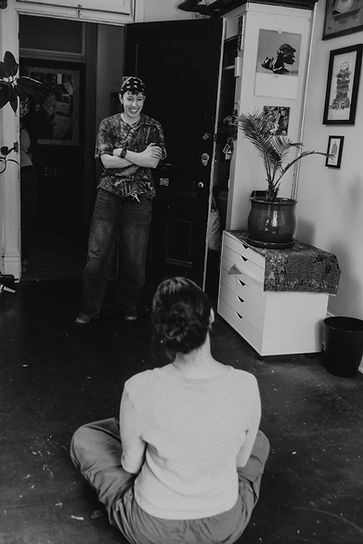CHOREOGRAPHY

TEACHING
PHILOSOPHY
The Self in the Classroom.
As a queer and non-binary dance artist and educator, I came of age in classrooms where my identities were invisible. Dance, shaped by cis-heteronormative and Eurocentric traditions, rarely offered space for my full self to be seen, let alone celebrated. That absence became the foundation of my pedagogical mission: to create spaces where the nuanced complexities of identity, culture, and body are not only acknowledged but centered.
Pedagogical Praxis.
Creating trustworthy classroom spaces where identity, artistry, and belonging move together.
My teaching is rooted in the frameworks of Gloria Anzaldúa’s Nepantla and (b)(B)orderlands Pedagogy and Nyama McCarthy-Brown’s Critical Dance Pedagogy. These theories guide my approach across technique, composition, and theory courses, where I integrate embodied practices like testimonio (embodied narrative) and plática (informal dialogue) to foster community, reflection, and co-creation. Each class begins in a circle, where students share names, pronouns, and respond to a daily prompt that grounds them in their bodies and lived experiences. This ritual builds trust and establishes a consistent space for vulnerability and connection.
I value artistic and physical rigor that supports students in discovering a sense of belonging through movement. My vocabulary draws from Hip Hop and contemporary forms, emphasizing isolation, dynamic floorwork, and rhythmic articulation. I teach with multiple learning modalities in mind, offering verbal cues, visual demonstrations, and consensual tactile feedback. Consent is central to my classroom, and I regularly check in to ensure students feel safe and supported in their learning.
Improvisation and dance-making are essential to my technique and composition courses. I offer prompts that decenter Eurocentric aesthetics and invite students to explore movement through their own cultural and personal lenses. Writing, discussion, and reflection are woven into these practices, allowing students to integrate their identities into the creative process and deepen their relationship to movement as a form of self-expression.
In theory-based courses, I extend these values by centering LGBTQIA2+ narratives, non-Western dance forms, and BIPOC voices. I challenge colonial frameworks in dance history and scholarship, encouraging students to connect course content to their own sociopolitical, cultural, and spiritual identities. As someone who rarely saw myself reflected in academic dance spaces, I am committed to ensuring that all students see themselves as part of the lineage they are studying.
I believe the body is a site of knowledge, memory, and possibility. Dance offers a space to navigate the in-between—where identity, lineage, and culture intersect. In a time when DEI initiatives and queer and trans* rights are under attack, cultivating trustworthy, inclusive classrooms is not just pedagogical, it’s political.
I teach so that students can find belonging in their bodies and their art, especially when that belonging is denied elsewhere.